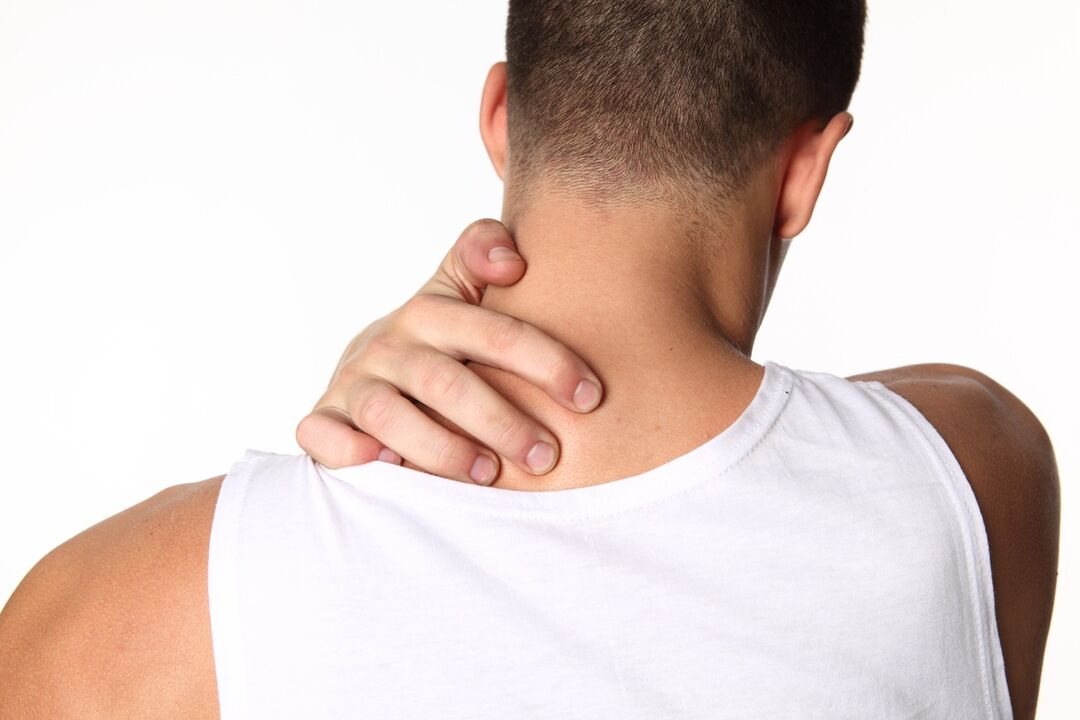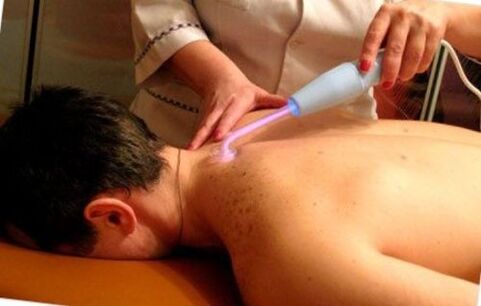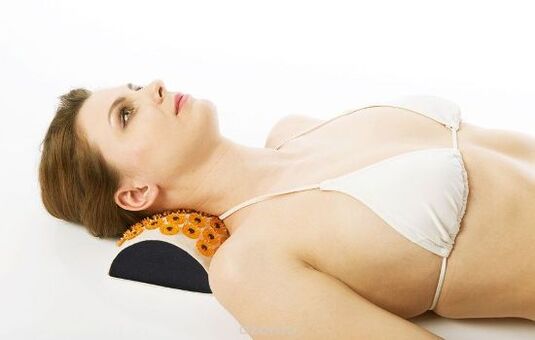
Osteochondrosis is a disease that affects the intervertebral discs and causes the development of reactive changes in the paravertebral (paravertebral) structures. Under the influence of a number of factors, the fibrous ring breaks down and the nucleus pulposus penetrates it.
At this stage, without treatment, the pathological process ends with the rupture of the fibrous ring and becomes a disc herniation. This, in turn, begins to compress the spinal nerves or the spinal cord itself, causing compression syndromes.
Characteristics and stages of development
A distinctive feature of osteochondrosis of the cervical segment is a rather diverse set of symptoms, which include headache and dizziness, instability of blood pressure, feeling of lack of air, numbness of the upper limbs, etc. Sh.
All this not only brings significant discomfort in life, but also complicates the diagnosis, since a person does not immediately consult a neurologist, but goes to a cardiologist, orthopedist or therapist. Treatment of cervical osteochondrosis is prescribed taking into account two factors - physiological, which means the natural aging of the body, and pathological - the presence of inflammatory or degenerative processes in the patient.
Physiological changes consist in the replacement of the nucleus pulposus with fibrous tissue, and clinical manifestations occur only when the nerve roots are irritated. Pathological changes are observed outside the cartilage and necessarily accompany the compression of nerve endings and blood vessels. Symptoms include pain in various places, cramping and clicking when turning the head, muscle weakness or numbness.
The cervical region is the most mobile and experiences less stress than the thoracic and lumbar regions. In adults, they do not exceed 115 kg, and the lower part of the spine can withstand up to 400 kg of pressure. However, cervical vertebrae differ in their structure - they are narrower and higher, which makes them vulnerable to various injuries and dislocations.
Treatment of osteochondrosis of the cervical spine and its duration largely depends on the stage of the disease:
- At the initial stage of development, there are practically no symptoms, and only after a serious load or as a result of being in a static position for a long time, one feels strong fatigue and discomfort in the neck muscles;
- The second stage is characterized by a change in the configuration of the discs - they begin to flatten and sag, which causes instability of the spinal column. During movements, a pain syndrome appears, which is caused by the compression of the nerve roots by reducing the height of the intervertebral discs;
- In the third stage, a protrusion is formed, which leads to an intervertebral hernia. The nucleus pulposus gradually shifts and begins to protrude beyond the anatomical boundaries. The pain syndrome due to the stretching of the nerve endings or the spinal cord extends not only to the neck, but also to the entire collar, as well as to the upper limbs. Headache and dizziness are caused by narrowing of blood vessels;
- The fourth stage of osteochondrosis of the cervical spine is characterized by the destruction of discs and the formation of bone formations - osteophytes. Pain becomes constant, movements are limited, muscles weaken to atrophy. Symptoms intensify: loss of coordination is observed, visual and hearing acuity decreases. Cervical osteochondrosis cannot be cured at this stage and surgical methods are used.
Principles and methods of treatment
Osteochondrosis therapy is always comprehensive and includes not only medication, but also physical therapy, massage, exercise therapy, and diet. Emergency medications for severe pain are analgesics. Nonsteroidal anti-inflammatory drugs are no less effective.
With the help of non-steroidal anti-inflammatory drugs, it is possible not only to relieve pain, but also to remove swelling, improve blood circulation and eliminate inflammation of nerve endings. To enhance the effect, you can use ointments and creams that act directly on the source of pain and are safer than tablets.
During the remission period, heating and massage ointments containing bee venom and plant extracts are used. These drugs help to relieve muscle spasms, improve blood circulation and restore nutrition to inflamed tissues.
Several groups of drugs are prescribed for the effective treatment of osteochondrosis:
- muscle relaxants;
- B vitamins;
- chondroprotectors;
- vasodilators (vasodilators);
- Diuretics (diuretics);
- Means for improving blood circulation and improving the rheological properties of blood.
Normalization of blood circulation
Improving blood flow is one of the most important tasks in the treatment of osteochondrosis. Administration of vasodilators is necessary to activate microcirculation, to expand the vascular lumen to physiological norms and to thin the blood. As a result, the brain receives food and oxygen in the required amount, which has a positive effect on its functioning.
To relieve the patient from painful symptoms such as dizziness and spasm, combinations of vasodilator drugs with nootropics or antiplatelet agents are used. Depending on the stage of the disease and the patient's condition, medications can be prescribed that improve blood circulation.
For more effective treatment, these drugs are combined with antiplatelet agents, as well as nootropics. In case of severe blood circulation disorders, the doctor may prescribe a short-term course of injections; After the removal of acute symptoms, therapy is continued by taking tablets orally.
Elimination of muscle spasms
Osteochondrosis is always accompanied by muscle tension, where the pathological focus is located. The mobility of the affected area is reduced and pain appears. Skeletal muscle hypertonicity is usually considered a protective response to pain. Myorelaxants are prescribed to reduce muscle spasticity.
When treating with muscle relaxants, their effect on psychomotor reactions and ability to concentrate should be taken into account. This applies to patients whose professional activities require increased care, for example, car drivers.
Chondroprotectors
Chondroprotective agents are used to restore and strengthen the cartilage tissue of the intervertebral discs. With the help of these drugs, cervical osteochondrosis of the spine can be treated only in the early stages, since in advanced cases they will not have any effect.
In a healthy person, chondroitin is produced in sufficient quantities, which ensures complete hydration of the cartilage. If for some reason the synthesis of chondroitin is disturbed, the cartilage tissue loses moisture and becomes thinner.
Chondroprotectors contain chondroitin sulfate, glucosamine and hyaluronic acid in various combinations. When taken, the production of own chondroitin is activated, as a result of which the cartilage tissue becomes denser and the mobility of the spine is restored.
Medicines of the latest generation also contain additional substances - vitamins and anti-inflammatory components.
In most cases, patients are prescribed chondroprotectors in tablets, but sometimes intramuscular or intra-articular injections are required. It is also possible to use local products, but they have the least pronounced effect.
It should be noted that the effect of chondroprotective therapy will become noticeable only after a few months.
Physiotherapy
Is it possible to cure osteochondrosis of the cervical spine with physiotherapeutic methods? Unfortunately, it is impossible to get rid of the disease completely, and physiotherapy works only in combination with drug treatment. The main goal of the procedures is to stimulate recovery processes in the body and eliminate pain.
The most effective methods are:
- electrophoresis, which allows the delivery of drugs directly to the damaged area;
- ultrasound;
- magnetic therapy;
- Darsonval;
- laser.
The operation of electrophoresis is based on the use of low-power currents, which are supplied to special plates. There are tampons soaked in drugs under the plates. Since the electrical conductivity of the skin is quite low, the medicinal substances penetrate into the deep layers and relieve the patient's condition.
If electrophoresis was performed with an anesthetic, the pain syndrome is relieved, and the use of a vasodilator helps to increase blood flow.

The result of magnetic therapy is improvement of blood circulation and reduction of manifestations of the inflammatory process - swelling and pain. Magnet treatment can be performed at home, and in some cases it can partially replace medication. You will need a special device for this.
A low-intensity laser with an infrared spectrum is used to treat back diseases. Laser rays penetrate deep into the tissue and affect the deformed area of the spine. As a result, the metabolic processes of the cartilage tissue are activated, the nerve endings are freed from compression and the normal functioning of the muscle structures is restored.
A darsonval is a directional action device through a rapidly decaying pulse current. During the procedure, alternating current is supplied to the body through a glass electrode with gas and promotes:
- increased blood circulation;
- reduction of pain threshold of sensitivity;
- improving the function of the nervous system;
- normalization of blood vessel tone;
- Increase body protection.
It should be noted that Darsonval is used at any stage of osteochondrosis.
The healing power of massage
Massage for the treatment of cervical spine osteochondrosis is undoubtedly the most pleasant, affordable and effective therapeutic method. However, this should be entrusted to a qualified specialist. You can rub it in the collar area while sitting or lying on your stomach. The most important thing is that the patient is comfortable and rests.
The massage begins with insertion movements from the back of the head in the direction of the upper back. The neckline should also cover the sides of the neck. 10-12 strokes are performed with minimal effort so that the skin does not move relative to the muscles.
Longitudinal compression is done with the thumb and forefinger, which grasp the skin and, as it were, hold it. The impact is limited to soft tissues; Vertebrates do not participate in the process. Compression is done very carefully, especially in the first sessions. Movements go parallel to the spine, 5-6 times on each side.
The next technique is swirling. The muscles of the neck and upper shoulders are warmed up by circular movements of the half-bent fingers, first along the spine, and then on the sides of the neck. Since kneading affects the deep layers of the tissue, it is done according to the patient's diagnosis, so as not to aggravate the pathology.
In order to increase blood circulation by warming the skin, it is necessary to burn. It is performed by sawing movements of the fingers or the lateral surfaces of the hand.

Circular circular movements are also allowed. The rub starts from the upper part of the neck and gradually moves to the shoulder girdle, squeezing the trapezius muscle. If the patient experiences pain or discomfort, the effort should be reduced.
The session ends with strokes, you can replace them with low-intensity contractions. Finally, vibration is used. The total duration of the massage session is 25-30 minutes, the standard number of procedures is 10.
Orthopedic tools
Various orthopedic products are used to reduce the manifestations of osteochondrosis and enhance the effect of treatment. Particular attention should be paid to the position of the head and neck during sleep, because unpleasant symptoms are most felt during or after a night's rest - headache, increased blood pressure, dizziness and discomfort in the shoulders.
All these manifestations indicate a blood circulation disorder, and an orthopedic pillow will help correct the situation.
When choosing a product, you should consider the following options:
- The ideal shape for patients with osteochondrosis is rectangular. Pillows and square pillows can be used for short rest, sleeping on them is strictly not recommended;
- The height should be at least 5 cm, but not more than 10 cm;
- width - slightly wider than the sleeper's shoulders;
- Hardness - medium. Very soft or hard pillows are not suitable. In addition, orthopedic products are produced mainly of medium hardness.

Another useful device is a needle applicator, which can be easily used at home. This device is a spiked mat made of elastic material that is applied to the collar area.
The massager should be placed on a small narrow pillow or pillow so that the neck is kept bent and does not feel too painful. Models in the form of rollers are also sold, which are also suitable for the treatment of cervical chondrosis.
You can lay the needle on the mat or roller for up to half an hour, but 5-7 minutes are enough for the first sessions. When using, it is recommended to change the position of the body or twist. The procedure is carried out 1 or several times a day.
Dietary nutrition is also an important component of comprehensive treatment. Since excess weight often hinders a quick recovery, it is best to eliminate processed foods and fast food from the diet, and reduce the consumption of salt and sugary soda.
The question "Can cervical osteochondrosis be cured" will have a positive answer if the disease is detected at an early stage. With a competent approach to treatment and compliance with medical recommendations by the patient, you can achieve significant improvement and live a full, comfortable life even in old age. Be healthy!
















































